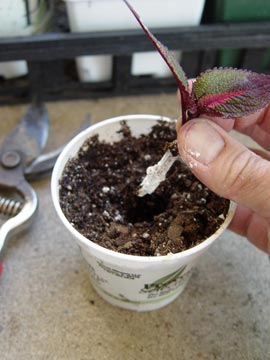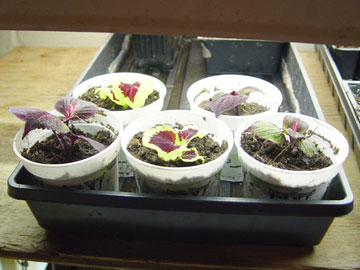The arrival of mid-autumn is a sad time for avid gardeners who don’t live in warm-winter parts of the United States. Fall’s first killing frost abruptly ends the growing season and takes with it all of that season’s tender plants. That means mushy marigolds, kaput cannas and no more tomatoes. But for those not willing to give it all up, there are ways to salvage at least some of this for another season.
 Pinch off the lowest sets of leaves of your 4- to 6-inch tip cuttings.
Pinch off the lowest sets of leaves of your 4- to 6-inch tip cuttings.
© George Weigel
One seemingly difficult but actually surprisingly easy technique is starting cuttings from existing plants. This involves producing new "baby" plants by snipping the stem tips off "mother" plants and encouraging them to root. If you can get this to happen, you've got small, replacement plants that can be kept alive inside over winter to plant back outside next spring.
Many tender plants and annual flowers readily root from tip cuttings. You don’t need a greenhouse, special lighting, rooting hormones or any other complicated paraphernalia to do it. Start by snipping 4- to 6-inch tips from the ends of plants you'd like to keep. It’s important to do this a few weeks before frost damages the plants. Pinch the lower sets of leaves off each cutting until you’re left with a bare-legged stick with one or two sets of small leaves at the top.
Next, stick the cuttings into small pots filled with a good-quality, light-weight potting mix. The goal is to place at least one and ideally two sets of nodes under the ground. A node is the area where those leaves were growing before you pinched them off. This is the part of the cutting where the new roots will emerge.
 A perilla cutting that’s been pinched and dipped in a rooting hormone powder is ready to be stuck in a pot of potting mix.
A perilla cutting that’s been pinched and dipped in a rooting hormone powder is ready to be stuck in a pot of potting mix.
© George Weigel
Keep the soil damp at all times. It may take several weeks, but if it’s going to work, roots will emerge. Once that happens, you've crossed the line from tip cutting to new plant. At that point, it’s a matter of keeping the young plants alive in winter by either growing them under lights or next to bright windows. Don’t be alarmed if the plants get "leggy" over winter. The point is to keep the roots alive. Once outside, these new plants can be cut back to produce denser, stockier new growth in the brighter light.
Help young plants along by starting to fertilize them toward the end of winter and again when they’re transplanted outside with a slow-release granular fertilizer. To produce even more new plants, take cuttings from your new plants in late winter the same way you did from the original mothers. Root those, and within several weeks, you’ll have lots of small plants for your beds in spring.
Among plants that are easiest to start from cuttings: coleus, alternanthera, flowering maple, fuchsia, geraniums, helichrysum, hibiscus, iresine, plectranthus, salvia and some begonias. The technique also works with many vines and woody shrubs.
 Rooted cuttings are growing inside over winter under these workshop lights.
Rooted cuttings are growing inside over winter under these workshop lights.
© George Weigel
One thing to keep in mind – watch for patented varieties. Patent protection means that you really shouldn’t make unauthorized copies of a plant, even just for at-home, personal use. Check the plant label when you buy to determine which varieties are patented and which aren’t. For patented varieties or plants that don’t root well from cuttings, try storing the originals inside over winter. Tender plants that are already potted can be moved inside as is. Just hose off or treat for any bugs, and then clean the pots.
In-ground tender plants can be potted up for the ride inside. Grow these plants near bright windows or under lighting until gradually acclimating them to the outside next spring. As with rooted cuttings, cut them back first if they’re getting too leggy, and begin fertilizing them in late winter. Tender bulbs, corms and tubers such as gladioli, cannas and dahlias can be dug after the first frost, cleaned and stored dormant inside in sawdust, peat moss or sand. And a few "survivor" plants such as some salvias, grasses and geraniums can be stored dormant in pots even in cold, unheated garages and sheds over winter. They’ll poke up new growth when the weather warms again in spring.